Morning show strategies are easier to implement if you’re a top-ranked, super-profitable station in a major radio market. But even modest radio stations in smaller markets can succeed, by being flexible and creative.
It’s the conclusion of a session on morning show strategies at the German Lokalrundfunktage 2012 for local broadcasters. A panel of programmers and consultants elaborated on creating radio promotions and morning show benchmarks to boost your personalities, show and station. One of the key things is focus on the quality; not the quantity of what you do.
“Thinking ahead is the mother of flexibility”
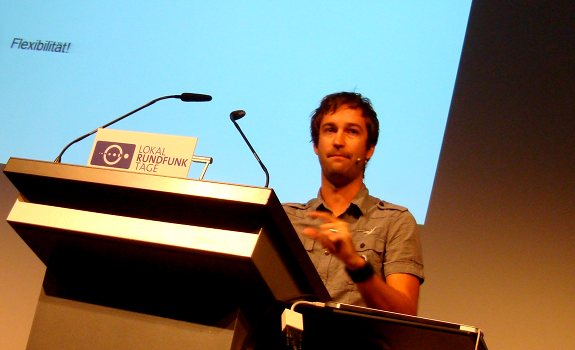
Sacha Gamper of FM1 knows that even a small team can achieve a lot by working efficiently (photo: Thomas Giger)
Serve your whole demographic
In the German-speaking part of Switzerland, public broadcaster SRF has a monopoly in terms of nationwide frequency coverage. That’s because privately-owned stations are allowed to operate on a local level only. In major cities there’s a lot of competition, although even Zurich cannot be compared to New York, London or Berlin. As the only private licensee in the eastern part of Switzerland, FM1 has a luxurious position. It runs a Hot AC format for a 20-40 year-old audience. The station tries to make content interesting for every part of the target demographic and fit the desired station image of being current, useful, local, and close to the audience. 216,000 listeners a day make FM1 the number 1 in its market.
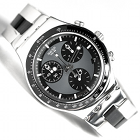 Schedule your time effectively
Schedule your time effectively
While major-market stations often have a dozen people on the morning team, FM1 proves that you can produce a morning show with a small team of dedicated radio professionals on a flexible working schedule:
– Host: present from 4 AM tot 12 PM
– Sidekick: present from 4 AM to 12 PM
– Producer: present from 8 AM to 5 PM (sometimes: 10 AM to 7 PM)
Build personalities with benchmarks
The FM1 Wachmacher (Wake-Up Crew) has benchmarks for every team member. Not just for host Yves Keller (‘Chäller’); also for his sidekicks Rosie and Joe, who is the producer. They use benchmarks to position the characters on the show. FM1 doesn’t have television stars and other celebrities on the morning team, nor the budget for TV spots to make them stars. “We have to create and reinforce our personalities on the air”, says Sacha Gamper, who is the station’s Head of Moderation & Production.
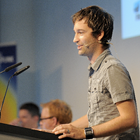 Take relevance as guideline
Take relevance as guideline
FM1 decided to use morning show benchmarks in a flexible way. There is always a benchmark at a given time but every day of the week, listeners could hear a different one, for practical reasons. The station doesn’t have someone who can record phone calls all day, in order to produce a high-quality candid phone bit every day. “We have to decide what’s the topic on day X, and what will be the suitable benchmark do something with it.”
Think quality – not quantity
For a station and market like theirs, less is more: “I rather run a small number of promotions, but make them really good”, as Gamper says. It happens that they don’t have a morning show promotion for 2 weeks in a row, and just make a good show with the usual ingredients. Sometimes they might decide to use some piece of content more than once, but make it really matter. “We think from the listener’s perspective. He tunes in, hears something, and just decides if he likes it or not.”

FM1 morning host Yves Keller (middle) with his sidekick Rosie Hörler and sidekick / producer Joe (photo: FM1)
Schedule ahead for flexibility
Sacha Gamper has learned that “flexibility is key when working in a small team, and thinking ahead is the mother of flexibility. Only when you plan beforehand, you can act flexible afterwards.” That’s why they not only talk about the next show, but also use the morning show meeting to discuss future events. If there’s an event they should cover, or do a special promotion around, they sometimes need to skip other content to find time for the preparation. FM1 used this flexible approach for a nice little stunt before the Tour de Suisse, an annual bicycle race through Switzerland.
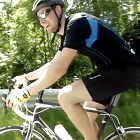 Use benchmarks for promotions
Use benchmarks for promotions
One day before the official event took place, morning show host Chäller jumped on a bike to ride a heavy stage of the tour. This includes a 30-kilometer road up into the Swiss mountains – really tough for the untrained radio presenter. FM1 decided to use an appropriate benchmark for this battle against the end of strength and willpower. In Chäller am Limit (Chäller against the limit), the morning show host has to accomplish a ‘mission impossible’.
Include many publicity moments
A good lesson from this example is that if you think ahead in a creative way, you can even turn a small stunt into a major promotion with many PR opportunities. Chäller’s tour was scheduled on a Friday. In the days before, listeners could vote whether he would make it or not, and a professional bicycle racer called in every morning. As a joke, a sports doc was interviewed about how they could dope the morning host, so he would be able to make the finish line.
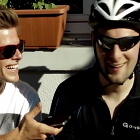 Combine on-air & off-air coverage
Combine on-air & off-air coverage
Chäller went on the road that Friday, accompanied by a cameraman and his producer Joe, who interviewed him several times. These bits were recorded with an iPhone. Through FTP, all audio files were automatically uploaded into the station’s on-air automation system. FM1 wanted to update the audience all day long, both on the radio and online through their website as well as Twitter and Facebook. The response was huge.
Follow up promotions afterwards
“Listeners called and emailed to ask where Chäller was right now, and when he would pass their town. People drove along with him on their bike and car drivers stopped to cheer him on”, Sacha Gamper recalls. FM1 managed to keep generating publicity through follow-ups after the actual event. During the next morning show, the host was treated with a muscle massage by a sports physiotherapist. Last but not least, all recorded audio and video of Chäller’s Tour de Suisse was uploaded to the FM1 website, social media profiles, and YouTube channel. “The result is a nice, relevant and listener-appealing promotion”.
“Morning show hosts should differentiate themselves
through more than just an X-chromosome”
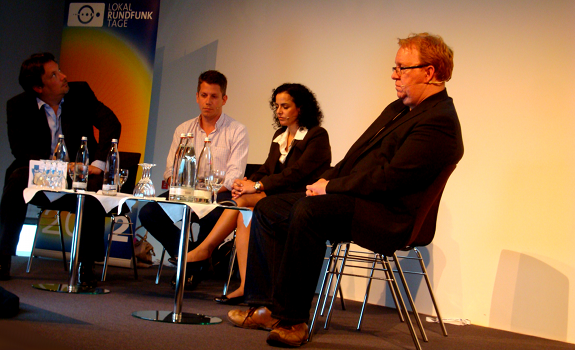
From left to right: session host Frank Salzbrenner (bci) with panelists Marc Haberland (104.6 RTL), Yvonne Malak (my radio), Nik Goodman (Bounce) and Sacha Gamper (FM1) who is standing (photo: Thomas Giger)
Combine personality and content
Radio consultant Yvonne Malak of my radio also shined her light on ‘the making of’ a successful morning show in smaller markets. She works with some larger stations like BB RADIO and Radio Hamburg, but also with a variety of locals. If you don’t have a sky-is-the-limit budget, a cost-effective morning show should first and foremost combine at least two likeable personalities with relevant content. “You need people who have something to say, and are good storytellers. You also need a sense for what topics will be interesting for your audience, and the ability to present them in a natural, personal and engaging way.”
 Put different personalities together
Put different personalities together
“I believe that your morning show hosts should differentiate themselves through more than just an X-chromosome.” Malak (photo) advises that morning show team members should represent different lifestyles. A married dad and a single woman are an example of a classic combination. Obviously this makes the show relate to as many people as possible [as long as you stay within the boundaries of your defined target demographic].
Dare to be different
Apart from approaching a topic from different angles, a morning show should also reflect different opinions. “Logically, with two opinions you reach out to much more people than if you have just one”, Yvonne Malak knows. Even an opinion that’s opposite of that of the majority is okay. Personalities should never be afraid to polarize; their co-host can always balance it by offering a contrary or different view. Malak also mentions the importance of sharing personal life stories on the air to with which listeners can identify themselves.
 Exploit sex, money & health
Exploit sex, money & health
How to find interesting topics? It’s basically everything people talk about right now; from fuel prices to TV highlights. Observing everyday life and listening to conversations can also provide inspiration. In her experience, sex, money and health are popular generic topics that appeal to every listener. Sex stands here for all topics around male/female differences, as well as relationship aspects to which people can literally ‘relate’.
Find inspiration through life
A very practical tip is to ask your morning show team what they’ve recently experienced within their personal life, including relationships, dating or being single, and turn that into content for the show. It can lead to topics like: ‘I’m over 50, single, and would like to fall in love again’ at one of Malak’s client stations. That presenter decided to start dating online and shared it openly on air – everything, from the first date, to the marriage, to the divorce a couple of years later… “All was real; nothing was fake.”
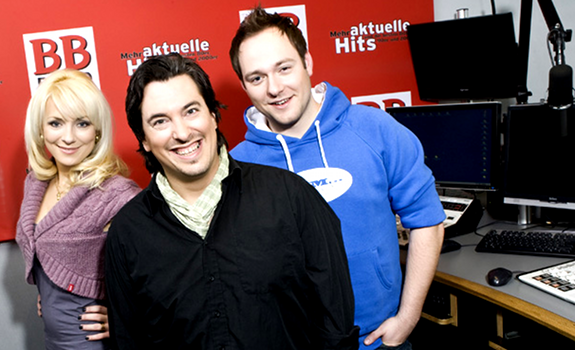
The team of BB RADIO’s Kaiser & Co: host Marcus Kaiser and his sidekicks Marlitt and Benni (photo: BB RADIO)
Have creative & different benchmarks
Yvonne Malak learned that benchmarks are very effective, especially if listeners relate to it directly. Her client station BB RADIO’s Kaiser & Co. morning show has Der kleine Unterschied und seine großen Folgen (The little difference and its huge consequences) – maybe inspired by Alice Schwarzer or Malcolm Gladwell? The station addresses little, everyday problems through listener interviews and expert advice. Malak speaks of “an own invention that costs practically nothing” that has become “one of the best-testing benchmarks”. ‘Why do men never listen?’ and ‘Why women can’t park cars?’ are some of its typical topics.
 Put being local second
Put being local second
When you’re working at a local station, it’s great if your topics have a local touch. But you could consider the entertainment factor to be even more important than being local. Yvonne Malak: “After a national football match, we talk about it, of course. The same goes for TV shows like Germany’s Next Top Model (photo) or Wer wird Millionair? (German version of Who wants to be a millionaire?). None of these topics is local, but all these topics are relevant.”
Be relevant & entertaining first
She summarizes that successful morning shows depend on personalities with different lifestyles who are good storytellers with interesting opinions, have real fun and give listeners the chance to identify themselves with them. This should be combined with relevant topics that reflect the audience’s lifestyle, preferably many male/female-relationship topics, and a couple of creative benchmarks. Malak’s advice is to “serve listeners something for breakfast every morning that has the chance to become something big in the market – a morning show with the header: entertainment.”
Read also:
- Programming (related articles)
- Morning Shows (related articles)
- Morning Show Benchmarks: Innovate Or Reinvent?
Stay tuned, follow us @RadioILOVEIT and click below to share this post





Hey Ed,
Many thanks, and pleasure!
Glad to hear you’ve found inspiration for your radio work here on the site.
Cheers,
Thomas
Thanks for all the pro radio tips.
I love radio, and enjoy learning more and more about radio – and how to do it better.
Sincerely,
Ed